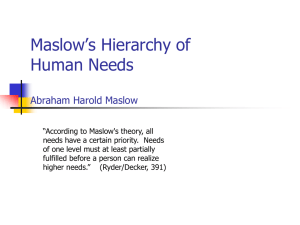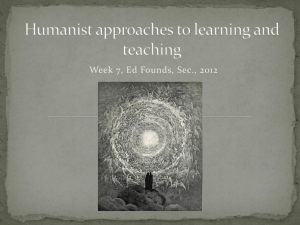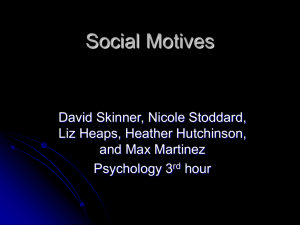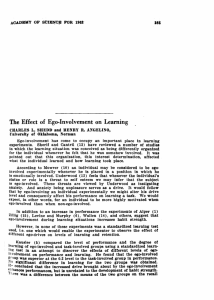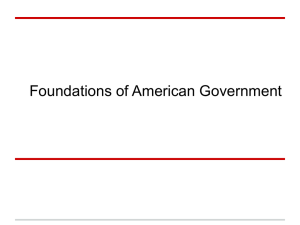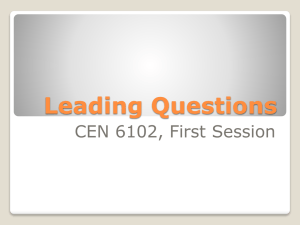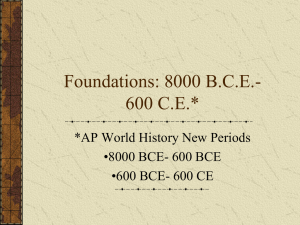MOTIVATION OT LEARN IN SCHOOL
advertisement
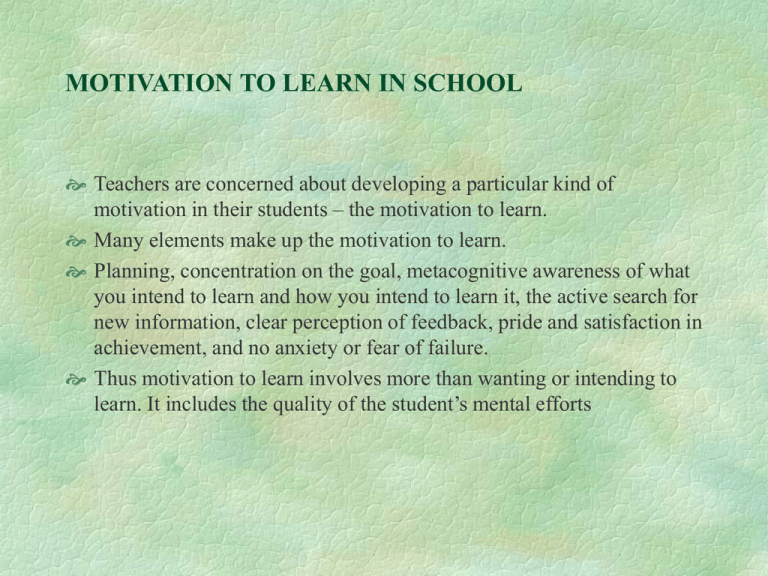
MOTIVATION TO LEARN IN SCHOOL Teachers are concerned about developing a particular kind of motivation in their students – the motivation to learn. Many elements make up the motivation to learn. Planning, concentration on the goal, metacognitive awareness of what you intend to learn and how you intend to learn it, the active search for new information, clear perception of feedback, pride and satisfaction in achievement, and no anxiety or fear of failure. Thus motivation to learn involves more than wanting or intending to learn. It includes the quality of the student’s mental efforts Three Major Goals for Teachers First get students productively involved with the work of the class; to create a state of motivation Finally, we want our students to be cognitively engaged – to think deeply about what they study; we want them to be thoughtful. to learn. Second and long term goal is to develop in our students the trait of being motivated to learn so they will be able “to educate themselves throughout their lifetime” We will examine the role of goals, needs, and beliefs in supporting motivation to learn. GOALS & MOTIVATION A GOAL IS WHAT AN INDIVIDUAL IS STRIVING TO ACCOMPLISH. Goal-directed behaviour: aware of some current condition, some ideal condition, and the discrepancy between the current and ideal situations. Goals motivate people to act in order to reduce discrepancy between “where they are’ and “where they want to be” Goal setting is usually effective for most people. Why Goals Setting Improves performance Goals direct our attention to the task at hand. Goals mobilize effort. Goals increase persistence. Goals promote the development of new strategies when old strategies fall short TYPES OF GOALS THE TYPES OF GOAL WE SET INFLUENCE THE AMOUNT OF MOTIVATION WE HAVE TO REACH THEM. Goals that are specific, moderately difficult, and likely to be reached in the near future tend to enhance motivation and persistence. Specific goals provide clear standards for judging performance. If performance falls short, we keep going. Moderate difficulty provides a challenge, but not an unreasonable one. Goals that can be reached fairly soon are not likely to pushed aside by more immediate concerns. TWO CATEGORIES OF GOALS IN CLASSROOM Learning and performance A learning goal is to improve, to learn, no matter how many mistakes you make or how awkward you appear. Students who et leaning goals tend to seek challenges and persist when encounter difficulties. Task-involved learners because they are concerned with mastering the task and are not worried about how their performance “measures up” compared to others in the class. Task-involved learners are more likely to seek appropriate help A Performance Goal. Students with performance goals are focused on how they are judged by others. They want to look smart and avoid seeming incompetent. If it seems impossible, they may adopt defensive, failure-avoiding strategies – they pretend not to care or they may simply give up. Ego-involved learner because they are preoccupied with themselves.List of behaviours as indicative of egoinvolved learners Goals Setting learning goals and being task-involved tend to increase motivation to learn, while working toward performance goals and being ego-involved diminish motivation to learn FEEDBACK AND GOAL ACCEPTANCE Besides having specific, challenges, attainable learning goals and focusing on the task, there are two additional factors that make goal-setting in the classroom effective. The firs is feedback. To be motivated by a discrepancy between “where you are” and “where you want to be,” you must have an accurate sense of where you are and how far you have to go. When feedback tells a student that current efforts have fallen short of the goal, the student can exert more effort or even try another strategy. When feedback tells the student that the goal is reached or exceeded, the student should feel satisfied and competent – competent enough perhaps to set a higher goal for the future. Feedback emphasizing progress is more effective GOAL ACCEPTANCE When students accept the goals set by their teachers or establish their own goals, then the power of goal setting to motivate learning can be tapped. But if students reject goals set by others or refuse to set their own goals, then motivation will suffer. Generally, students are more willing to adopt the goals of others if the goals seem realistic, reasonably difficult, and meaningful and if good reasons are given for the value of the goals. Goal acceptance might be greater (and more appropriate) if you work with students’ families to identify and monitor the goals. Guidelines... GOALS: LESSONS FOR TEACHERS Students are more likely to work toward goals that are clear, specific, reasonable, moderately challenging, and attainable within a relatively short period of time. If teachers focus on students performance, high grades, competition, and achievement, they may encourage students to set performance goals. This will undermine the students’ ability to learn and become task-involved. Students may not yet be expert at setting their own goals or keeping goal in mind, so encouragement and accurate feedback are necessary. If you use any reward or incentive systems, be sure the goal you set is to learn and to improve in some area, not just to perform well or look smart. And be sure the goal is not difficult. NEEDS & MOTIVATION MASLOW’S HIERACHY A need as “a biological or psychological requirement; a state of deprivation that motivates a person to take action toward a goal” Humanistic Theory of motivation - Maslow’s Hierarchy: Human have a hierarchy of needs ranging from lower-level needs for survival and safety to higher-level needs for intellectual achievement and finally self-actualization Self-actualization is Maslow’s term for self-fulfillment, the realization of personal potential. Four levels of needs - survival, safety, belonging, and selfesteem - deficiency needs. BEING NEEDS Being needs - three higherlevel needs - intellectual achievement, aesthetic appreciation, and selfactualization. When they are met, a person’s motivation does not cease; instead, it increases to seek further fulfillment Unlike the deficiency needs, these being needs can never be completely filled. The motivation to achieve them is endlessly renewed His theory has been criticized that people do not always appear to behave as the theory would predict. His theory gives us a way of looking at the whole person, whose physical, emotional, and intellectual needs are all interrelated. IMPLICATIONS FOR EDUCATION Students desires to fill lower-level needs may at times conflict wit ha teacher’s desire to have them achieve higher-level goals. BELONG To a social group and maintaining self-esteem within that group, for example, are important to students. If doing what the teacher says conflicts with group rules, students may choose to ignore the teacher’s wishes or even defy the teacher. ACHIEVEMENT MOTIVATION DAVID McCLELLAND & JOHN ATKINSON. People who strive for excellence in a field for the sake of achieving, not for some reward, are considered to have a high need for achievement. Two explanations for the source of achievement motivation 1.As a stable and unconscious traits - something the individual has more or less of. The origins are assumed to be in the family and cultural group of the child. 2. As a set of conscious beliefs and values shaped mainly by recent experiences with success and failure and by factors in the immediate situation such as the difficulty of the task or the incentives available. RESULTANT MOTIVATION Atkinson noted that all people have a need to avoid failure as well as a need to achieve. If our need to achieve in a particular situation is greater than the need to avoid failure, the overall tendency, or resultant motivation, will be to take the risk and try to achieve. But if the need to avoid failure is greater, the risk will be threatening rather than challenging, and the resultant motivation will be to avoid the situation. Motivation to achieve encourages motivation to learn, while anxiety and fear of failure diminish motivation to learn A moderate amount of failure can often enhance their desire to pursue a problem. Success gained too easily can decrease M. THE NEED FOR SELF-DETERMINATION (SD) SD is the need to experience choice in what we do and how we do it. It is the desire to realize our own wishes, rather than have external rewards or pressures determine our actions. Self-and other-determination, deCharms used the metaphor of people as “origins” and “pawns” Origins perceive themselves as the origin or source of their intention to act in a certain way. As pawns, people see themselves as powerless participants in a game controlled by others As origins, students are active and responsible, but as pawns, they are passive and they take little responsibility for school work. Students are too little governed by their own intrinsic motivation and too powerless over external controls and demands.
